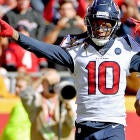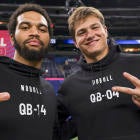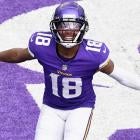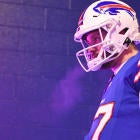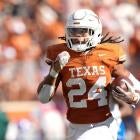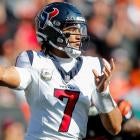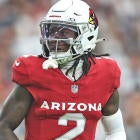Chris Towers and Frank Stampfl recently put together lists of the best Fantasy baseball advanced stats for hitters and pitchers. The adoption and creation of advanced stats in baseball are, of course, well ahead of football data for a variety of reasons, not least of which is because of something I like to call multivariability — the reality that on every football play, it is difficult to separate one player's success or failure from the other 21 players on the field. Line play is perhaps the most obvious additional variable on every snap, but quarterbacks and pass-catchers have to operate in a tandem, and offensive and defensive schemes also rank among the many elements that impact individual player success and failure.
That also makes football data more open to interpretation. There are no perfect football stats, and yet that doesn't stop us from trying. The Fantasy football community has access to plenty data, and you can find any number of metrics to make a pro or con case for nearly any player. Given that, it might be tempting to just throw up your hands and stick to good ol' Fantasy points earned and allowed; as an analyst and Fantasy player who relies heavily on data, I will readily admit that isn't the worst thing you could do.
But there's also an edge to be found through understanding what data matters and what doesn't. At its base, Fantasy football is still an opportunity game, and metrics that discuss opportunity tend to be more useful than those that measure efficiency. The simplest way to consider how opportunity and efficiency combine to create Fantasy points is that opportunity is typically measuring what happens before a player has the ball — how often he's targeted, given a handoff, out in a route — while efficiency is measuring what happens once the ball reaches him — whether he catches it, how many yards he gains.
We talked about all of this and more on Thursday's episode of Fantasy Football Today. Listen below and be sure to subscribe for non-stop Fantasy football content.
Here is the data I tend to stick to, and why it matters.
Market share/Target share (MS)
What does it mean? Market share refers to the percentage of a given stat a player accounts for among his team's total in that stat. The most common use is target market share or target share, which represents the percentage of a team's pass attempts a player was targeted on.
Why does it matter? Stats like team passing volume can fluctuate year over year, in this case because pass rate is heavily influenced by how frequently a team trails in games. In prospect research, market share data helps control for the wide range of offenses prospects can play in, from pass-happy spread systems to old-school run-heavy offenses, and considering production as a percentage improves predictability compared to looking at raw stats.
Some key results from 2019
- Despite some low-target games, A.J. Brown's 25% target share from Week 10 on — when he first played more than 70% of his team's snaps — would have been a top-10 figure over the full season. During that time, Tennessee was on pace for fewer than 400 pass attempts, which no team has done in a full season since 2005. Tennessee's offense likely can't be as efficient over a full 2020 season as they were in this stretch, meaning if Brown can maintain (or grow) his share, his targets per game would be expected to increase.
- DeAndre Hopkins was one of just two players, along with Michael Thomas, to have at least a 30% share of targets. Hopkins moving to Arizona could limit his share, but the Cardinals may also throw more overall. Meanwhile, the Texans have a lot of targets to replace.
- Among 2020 prospects, Justin Jefferson actually accounted for a higher market share of LSU's passing yardage in his 875-yard sophomore season than his 1540-yard junior year, owing to the fact that LSU more than doubled their overall passing output from 2018 to 2019. The doesn't mean we ignore the raw stats, but Jefferson played more on the outside as a sophomore before becoming a primary slot guy in 2019, so the narrative that his production exploded because he moved inside needs more scrutiny when we consider team context.
Where can you find it? The stat was coined at RotoViz, and is available in many of their tools. airyards.com and PlayerProfiler are other good sources.
Air yards/aDOT
What does it mean? Air yards/average depth of target. It measures how far downfield from the line of scrimmage a pass is thrown. Air yards is the cumulative total of all passes; aDOT is the average depth.
Why does it matter? Air yards are to receiving yards what targets are to receptions. They measure the total available opportunity a player received in yardage, and while targets are still more predictive of Fantasy success, Josh Hermsmeyer of FiveThirtyEight and airyards.com has found that air yards and targets combined are more predictive than just targets. Josh's Weighted Opportunity Rating (WOPR) considers a player's share of his team's targets and air yards — weighted so that targets are worth more than air yards.
Air yards and aDOT help us quantify a player's role in a way targets alone can't. A high aDOT typically means a lower catch rate but more yards per catch; a low aDOT is the inverse. Players with low aDOTs do tend to gain more yards after the catch (YAC), on average.
Some key results from 2019
- Five-year aDOT for all WR: 11.1 yards
- Five-year aDOT for all TE: 7.6 yards
- Low aDOT: Michael Thomas, Cooper Kupp, Jonnu Smith — Thomas and Kupp are examples of players who see plenty of targets at below-average depths, typically posting high catch rates and high rates of yards after the catch. Smith's aDOT was among the lowest at tight end, and he also relied heavily on YAC, which can be unstable year over year. Smith's role will need to expand, as his limited production in 2019 was reliant on schemed screen plays.
- High aDOT: Mike Williams, Curtis Samuel, Mike Gesicki — Williams had by far the highest aDOT among players with at least 70 targets at 18.1, and any increased usage in shorter areas of the field could allow his target share to rise. Despite just 627 receiving yards, Samuel had the ninth most raw air yards in the NFL. Gesicki's high aDOT and frequent slot usage helped him to the fourth most air yards among tight ends. Both Samuel and Gesicki are examples of young players who greatly underperformed their opportunity, though Samuel will now contend with Robby Anderson for downfield targets and may even see a role change. Gesicki is a smart late-round upside bet at tight end.
Where can you find it? airyards.com/tables.html is my go-to source.
Yards/Fantasy points per route run (YPRR)
What does it mean? Self explanatory. How many yards or Fantasy points a player averaged per route they ran.
Why does it matter? Routes run provide a more detailed look at receiving opportunity than snaps, particularly for tight ends and running backs who will pass block at times. Looking at yards or fantasy points per route run is a more holistic way to consider rate performance than stats like yards per target. An important note: Many say YPRR is a better efficiency stat than YPT, and it does provide a better picture. But that's because the difference between the two is an opportunity measure — targets per route. Adding in an opportunity measure will typically always improve the accuracy of an efficiency stat.
Some key results from 2019
- 2019 league-wide RB YPRR: 1.21
- 2019 league-wide WR YPRR: 1.50
- 2019 league-wide TE YPRR: 1.31
Much like YPT, YPRR is influenced by the depth at which players see targets — downfield throws naturally lead to more yards per target or route run, even when controlling for the lower catch rate on such plays. Players who were efficient at high aDOTs were among the league leaders in YPRR, including Stefon Diggs, A.J. Brown, Tyreek Hill, Julio Jones, Mike Evans and Amari Cooper. Michael Gallup, Courtland Sutton, Terry McLaurin, Will Fuller, John Brown and John Ross are all top-25 receivers by this metric. Among lower-aDOT players, Michael Thomas led the NFL, while Cooper Kupp and Hunter Renfrow also finished top 12, and all three did so thanks to strong YAC totals. Renfrow in particular is an example of a small sample likely being skewed by two touchdowns of 65 and 56 yards, both of which were short slants he took to the house. It's important to keep in mind how interconnected all of these stats are, and that unfortunately no one stat paints the full picture for a player.
At tight end, George Kittle and Mark Andrews dominate the YPRR leaderboard. They do that in part because they are easily the tight end leaders in targets per route run; both are very good and also play in offenses that utilize deception to scheme them looks. YPRR is often cited as better than YPT when we consider players like O.J. Howard, who grades similarly to Kittle and Andrews in terms of YPT. But Howard looks worse in YPPR due to a very low rate of targets per route. An ability to draw targets is a skill in itself, but the distinction is nevertheless important. Again, YPRR is a very good holistic stat, but it's a "better efficiency stat" due to an added opportunity element.
Where can you find it? Most route data is behind a paywall, including at Pro Football Focus and Sports Info Solutions. PlayerProfiler provides YPRR and Fantasy points per route run on their player pages.
TRAP/HVT
What does it mean? Trivial Rush Attempt Percentage and High-Value Touches, for running backs. This is a stat I created last offseason, and it's basically trying to weigh the most valuable touches running backs get from the ones that don't change their Fantasy appeal much. Here, a high-value touch is defined as any reception and any touch inside the 10-yard line. That leaves all rush attempts outside the 10-yard line as "trivial" rushes that don't move the Fantasy needle; TRAP is a measure of what percentage of a running back's total touches are these low-value opportunities.
Why does it matter? Running back is an opportunity-driven position, and opportunity stats will always hold the most significant edge over efficiency when analyzing it. Stats like tackles evaded/avoided or other measures of running back efficiency pale in comparison to raw snaps, snap share and touches.
High-value touches are a way to weight the opportunity toward what matters most, and TRAP is a useful way to understand which players can do more with fewer touches.
Key results from 2019
- High TRAP: Josh Jacobs, Derrick Henry
- Mid TRAP: Saquon Barkley
- Low TRAP: Christian McCaffrey, Austin Ekeler
TRAP alone won't tell you who is successful, but since the Fantasy football market tends to value running backs in terms of touches, it can help you understand who may be over- or undervalued. Players like Henry can still be effective through huge low-value touch numbers and efficiency, but we also know that high touch counts can increase injury risk. The monster upside of someone like McCaffrey can be explained through not just his massive snap shares and touch counts, but how many of his touches were the high-value variety.
Where can you find it: I posted data for all of 2019's 200-touch backs in a Henry story after the season, and prior years' player and team data can be found last offseason. I will continue to cover the implications of this stat soon, but am not aware of any site that currently lists full data.
Game script
What does it mean? The average score differential in a given game or season. It measures whether a team played from ahead or behind.
Why does it matter? Understanding game script, and how it might change, helps us understand potential team-level volume changes. Teams that trail tend to throw more, while teams that are ahead run more. Winning teams also tend to run more plays than losing teams, though teams that trail tend to play faster while teams that lead tend to play slower.
Game script is probably more useful for Fantasy on a week-to-week level in-season than looking at full-season results.
Key results from 2019
- Plus game script: Baltimore, San Francisco and Minnesota were the only three teams to run more times than they passed, and all three were among the top-six teams in average game script. All project to be run-heavy again, but if they aren't as good in 2020 for any reason, game situations may dictate them having to throw more. By comparison, the Chiefs had the sixth-fewest rush attempts in the league despite the third-highest average game script, so their pass tendencies seem stable.
- Negative game script: Most heavily negative script teams have new personnel, so it's difficult to read too much into it. The Bengals had the worst average game script in the league, but still ran the ball more than seven other teams. They're one candidate to be somewhat better in 2020, and it could mean more running than we'd expect at first glance.
Where can you find it? PlayerProfiler's running back pages are a good source
Pace/play volume
What does it mean? Pat Thorman of Establish The Run (and formerly of PFF) is my most-trusted source for this stat, and I'll let him clarify the distinction between these two stats from his primer:
Why does it matter? Football is an opportunity game, and play volume in an offense helps dictate the upside of all the Fantasy pieces. Pace helps us understand whether play volume was the result of the team intentionally playing fast or factors like game script that influenced their behavior.
Key results from 2019
- Fast pace: Despite plenty of hype around Kliff Kingsbury's offensive style, the Arizona Cardinals ran just the 22nd most plays last season. But they were fourth in situation neutral pace, suggesting improved offensive efficiency that keeps them in more drives and games could help their play volume spike in year two.
- Slow pace: Baltimore has been a high-volume offense for several seasons, but after finishing top six in situation-neutral pace in 2016, 2017 and 2018 (largely with Joe Flacco under center and a pass-heavy offense), they had the sixth-slowest situation-neutral time to snap in 2019 (and the slowest time to snap overall if we consider all game situations). They ran the seventh-most plays in the league last year, but as a run-heavy team now, their play volume could decrease if their offensive efficiency does.
Where can you find it? Football-Outsiders for pace, Pro-Football-Reference for play volume












